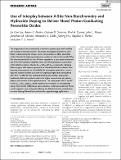Files in this item
Use of interplay between A-site non-stoichiometry and hydroxide doping to deliver novel proton-conducting perovskite oxides
Item metadata
| dc.contributor.author | Lee, JinGoo | |
| dc.contributor.author | Naden, Aaron Benjamin | |
| dc.contributor.author | Savaniu, Cristian Daniel | |
| dc.contributor.author | Connor, Paul Alexander | |
| dc.contributor.author | Payne, Julia Louise | |
| dc.contributor.author | Skelton, Jonathan | |
| dc.contributor.author | Gibbs, Alexandra | |
| dc.contributor.author | Hui, Jianing | |
| dc.contributor.author | Parker, Stephen | |
| dc.contributor.author | Irvine, John Thomas Sirr | |
| dc.date.accessioned | 2021-08-26T15:30:12Z | |
| dc.date.available | 2021-08-26T15:30:12Z | |
| dc.date.issued | 2021-10-07 | |
| dc.identifier | 274986553 | |
| dc.identifier | 76ffca11-5cf6-4bea-9f2a-fe3fcf6daa51 | |
| dc.identifier | 85113381072 | |
| dc.identifier | 000688519400001 | |
| dc.identifier.citation | Lee , J , Naden , A B , Savaniu , C D , Connor , P A , Payne , J L , Skelton , J , Gibbs , A , Hui , J , Parker , S & Irvine , J T S 2021 , ' Use of interplay between A-site non-stoichiometry and hydroxide doping to deliver novel proton-conducting perovskite oxides ' , Advanced Energy Materials , vol. 11 , no. 37 , 2101337 . https://doi.org/10.1002/aenm.202101337 | en |
| dc.identifier.issn | 1614-6832 | |
| dc.identifier.other | ORCID: /0000-0002-8394-3359/work/99115734 | |
| dc.identifier.other | ORCID: /0000-0002-1492-7590/work/99115938 | |
| dc.identifier.other | ORCID: /0000-0003-3324-6018/work/99116162 | |
| dc.identifier.other | ORCID: /0000-0003-2876-6991/work/110912164 | |
| dc.identifier.uri | https://hdl.handle.net/10023/23846 | |
| dc.description | Funding: UK Engineering and Physical Sciences Research Council (Grant Number(s): EP/R023522, EP/R023751, EP/L017008, EP/P007821, EP/L000202, EP/R029431); Diamond Light Source (Grant Number(s): SP17198-8); Rutherford Appleton Laboratory (Grant Number(s): RB1920629). | en |
| dc.description.abstract | The magnitude of ionic conductivity is known to depend upon both mobility and number of available carriers. For proton conductors, hydration is a key factor in determining the charge–carrier concentration in ABO3 perovskite oxides. Despite the high reported proton mobility of calcium titanate (CaTiO3), this titanate perovskite has thus far been regarded as a poor proton conductor due to the low hydration capability. Here, the enhanced proton conductivity of the defective calcium titanate Ca0.92TiO2.84(OH)0.16 prepared by replacing lattice oxygens with hydroxyl groups via a solvothermal route is shown. Conductivity measurements in a humidified Ar atmosphere reveal that, remarkably, this material exhibits one order of magnitude higher bulk conductivity (10−4 Scm−1 at 200 °C) than hydrated stoichiometric CaTiO3 prepared by traditional solid-state synthesis due to the higher concentration of protonic defects and variation in the crystal structure. The replacement of Ca2+ by Ni2+ in the Ca1−xTi1O3−2x(OH)2x, which mostly exsolve metallic Ni nanoparticles along orthorhombic (100) planes upon reduction, is also demonstrated. These results suggest a new strategy by tailoring the defect chemistry via hydration or cation doping followed by exsolution for targeted energy applications. | |
| dc.format.extent | 7 | |
| dc.format.extent | 2993500 | |
| dc.language.iso | eng | |
| dc.relation.ispartof | Advanced Energy Materials | en |
| dc.subject | Defect chemistry | en |
| dc.subject | Exsolution | en |
| dc.subject | Hydration | en |
| dc.subject | Perovskite | en |
| dc.subject | Proton conductivity | en |
| dc.subject | QD Chemistry | en |
| dc.subject | TK Electrical engineering. Electronics Nuclear engineering | en |
| dc.subject | DAS | en |
| dc.subject.lcc | QD | en |
| dc.subject.lcc | TK | en |
| dc.title | Use of interplay between A-site non-stoichiometry and hydroxide doping to deliver novel proton-conducting perovskite oxides | en |
| dc.type | Journal article | en |
| dc.contributor.sponsor | EPSRC | en |
| dc.contributor.sponsor | EPSRC | en |
| dc.contributor.sponsor | EPSRC | en |
| dc.contributor.sponsor | EPSRC | en |
| dc.contributor.institution | University of St Andrews. School of Chemistry | en |
| dc.contributor.institution | University of St Andrews. Centre for Energy Ethics | en |
| dc.contributor.institution | University of St Andrews. St Andrews Sustainability Institute | en |
| dc.contributor.institution | University of St Andrews. EaSTCHEM | en |
| dc.contributor.institution | University of St Andrews. Centre for Designer Quantum Materials | en |
| dc.identifier.doi | 10.1002/aenm.202101337 | |
| dc.description.status | Peer reviewed | en |
| dc.identifier.grantnumber | EP/R023522/1 | en |
| dc.identifier.grantnumber | EP/R023751/1 | en |
| dc.identifier.grantnumber | ep/l017008/1 | en |
| dc.identifier.grantnumber | EP/P007821/1 | en |
This item appears in the following Collection(s)
Items in the St Andrews Research Repository are protected by copyright, with all rights reserved, unless otherwise indicated.

